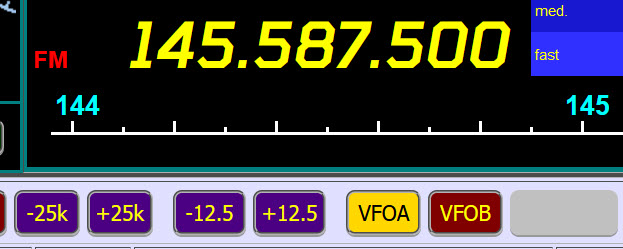2.6 Tuning controls and RIT / XIT
Band switching: The band buttons change band on the radio which switches to a designated frequency
for the new band. The new band's choice of initial frequency is a radio feature ( Usually from last usage.)
piWebCAT is continually monitoring the radio's frequency.... of both VFOs if possible.
(The IC7000 only appears to have a CAT command to read the current VFO. piWebCAT therefore has a
rig table option to suppress the display of the background VFO's frequency)
piWebCAT with change band display (band tuning scale) on detecting a changed current VFO frequency
that is within the limits of a new band.
piWebCAT does not change band just because the radio's frequency has left the old band.
If you tune the radio beyond the band edge, the piWebCAT band display will only change band when
you reach a new band.
Note that band edges are in the bands database table and so can be changed.
However, the band limits of the tuning scale are, by necessity, fixed in the code.
Thus, if a band were to be extended, you could extend the band limits so as to have the correct
band display selection behaviour. Tuning into the extended area would simply go off-scale.
The older Yaesu radios such as FT920, FT100MP MkV ( YAESU5 option) do not have a band-select command.
Each band select button is therefore configured with your choice of start frequency for each band.
On band change, the button sends the frequency to the radio, piWebCAT then responds to the radio's
frequency change by switching its tuning scale display to the chosen band.
Coarse frequency setting - click the tuning scale - the frequency changes and the marker moves.
Fine tuning
Use the blue tuning band with horizontal mouse (or finger) drag OR with the mouse thumbwheel.
The tuning band has fast, medium and slow lanes.
The response of each lane is user configurable in the settings database table.
(ie; Hz / pixel for mouse/finger drag and Hz/click for the thumbwheel)
RIT and XIT slider - use of mousewheel
![]()
RIT and XIT control can be assigned to sliders as shown above.
Using Firefox as a the web browser, the mousewheel can be used to tune in fine steps of 1/400 th of the span.
In the case of the FTdx101D shown above, that is 1/400 th of -9990 to to +9990 Hz = 50Hz per step.
With the mouse pointer over the slider, the mousewheel is clicked and thereafter can be used for fine tuning.
Browsers: Chrome and Opera do not provide this feature at the time of writing. This may change !
Frequency up/down buttons
|
The user can program any button as a frequency Up or Down button. Here, I have four such buttons in my IC7000 Hamlib configuration. They are: +/- 25 kHz and +/- 12.5 kHz. The first click moves the frequency to the next multiple of 12.5 kHz or 25 kHz. Thereafter the buttons step at the specified interval. |
Duplex / simplex switching
|
For repeater operation, I configured the three buttons shown for the IC7000. |
